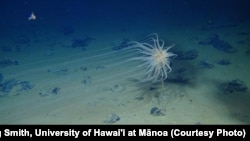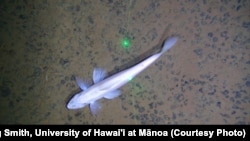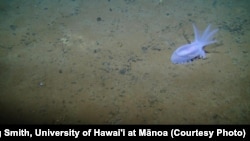The ocean is one of the last frontiers on Earth. But the world's ever-growing need for minerals and metals is pushing humans to boldly go where no human has gone before and they’re finding new life in the process.
Scientists at the University of Hawaii at Manoa studied a 900-square-kilometer region in the Clarion-Clipperton Zone (CCZ) in the Pacific Ocean. Their mission: to seek out new life and new marine civilizations. They published the results of their first deep sea dive in the latest issue of Nature Scientific Reports.
Into the abyss
The CCZ is a flat expanse of seabed nearly the size of the United States, nestled between the mountainous Clarion and Clipperton Fracture Zones, between Central America and the Hawaiian islands. It is known to contain an array of minerals, such as copper, nickel and cobalt, contained in potato-sized clumps (5-10cm). These metallic nodules are scattered along the seafloor, 3,000 to 6,000 meters below the ocean surface.
The International Seabed Authority (ISA) licensed a specific area of the CCZ to UK Seabed Resources Ltd. for exploration. But before the company can begin mining operations, the ISA mandated that it complete a biological study of the region.
That’s when Diva Amon, a post doctoral researcher at the University of Hawaii, got involved. UK Seabed Resources hired the ABYSSLINE project, to determine what marine life exists in its contract region and how those organisms depend on the mineral deposits.
“Stereotypically, us deep sea biologists think that there is not a lot living in the abyss, but we found that actually there is quite a lot living there,” Amon, assistant director of the ABYSSLINE project, tells VOA. “More than half the animals we collected were completely new to science. It just shows how much more work needs to be done in that area because we know so little.” Her group found a new species of anemone and two new species of sponges, but that's not what has them excited.
Three of the specimens Amon collected were not just newly-identified species, the researchers had to create new, higher-level genus classifications for them. Two of these new genera are in the coral family and the third is a completely new genus and species.
Biological oceanographer Paul Snelgrove, who participated in a decade-long global census of marine life a few years ago, notes that finding new species in the deep ocean is pretty common. But the Memorial University of Newfoundland professor says the need for new genera “is really quite profound.”
Nodule dwellers
Amon’s work also focused on the metallic "potatoes." She found more than half of the animals collected were attached to the nodules. The CCZ terrain is soft, flat seafloor and nodules provide the only hard surface where these creatures can affix themselves.
“If mining happens across the entire area, this ecosystem will just be decimated,” Amon cautions.
That is why these studies are so important, says Snelgrove, who was not affiliated with the ABYSSLINE project. “It’s likely we are going to develop at least some aspect of these deep ocean environments and we should try to do that with knowledge in hand and do it in a way that’s going to minimize our impact.”
“There is a scientific push to slow things a bit so that the science can be done … so this [mining] can be done as sustainably as possible,” says Amon.
A 2013 press release on Lockheed Martin’s website announcing the contract given to UK Seabed Resources by the ISA states the subsidiary is “working closely with U.K. government departments and research institutions on environmental and industrial elements of the project.”
VOA reached out to UK Seabed Resources for comment but company officials did not respond in time for this article.
More dives into the deep
The ABYSSLINE project has a five-year mission and Amon expects that more new species and genera will be discovered on future cruises.
“I’m looking at year two [data] and already ... I’m seeing ... new stuff,” she says excitedly.
“The deep sea is just this fascinating place where there are so many things that no one has ever seen before that are weird and wonderful," she added. "This is one of the last areas where there hasn’t been wide scale impact by humans. So we need to be careful and hopefully by doing the studies that we’re doing, we can provide the data that can be used to manage the areas as best as possible.”
It appears there are still plenty of strange new worlds to explore here on Earth.








